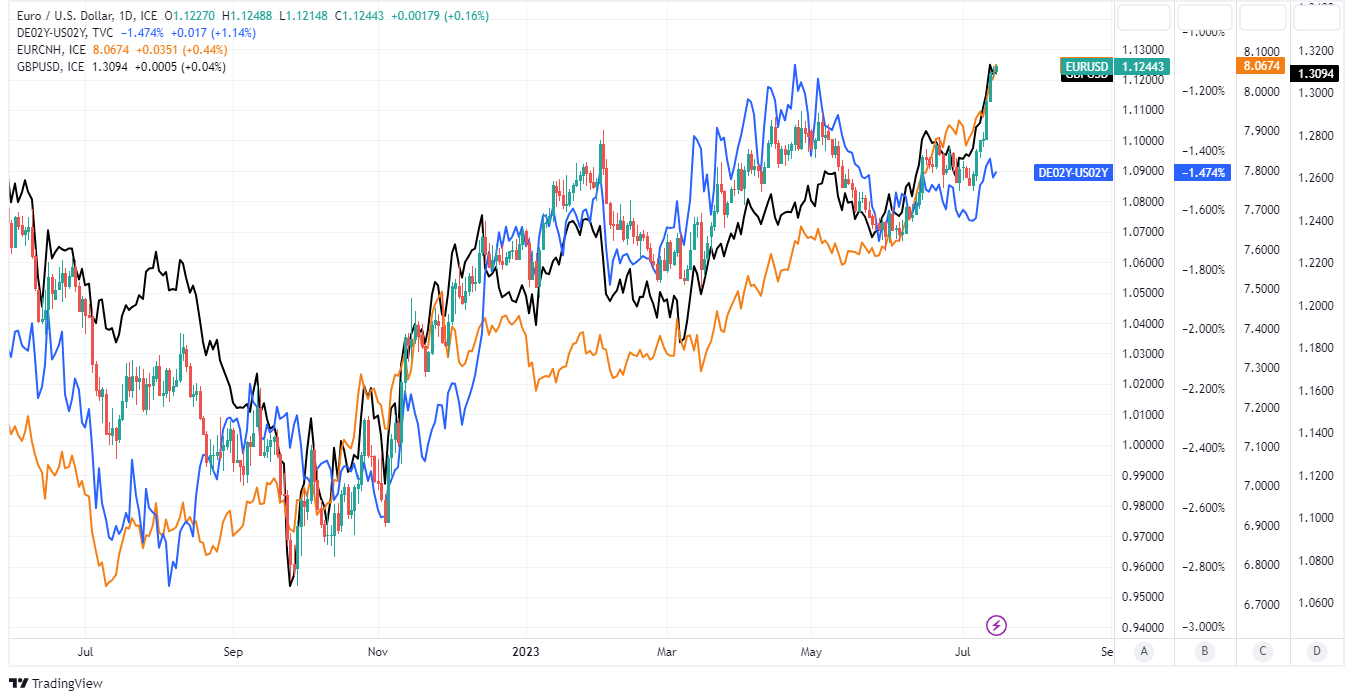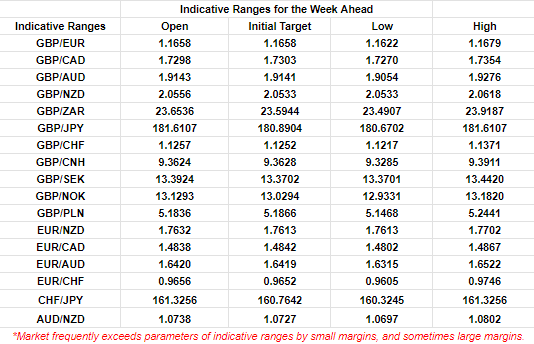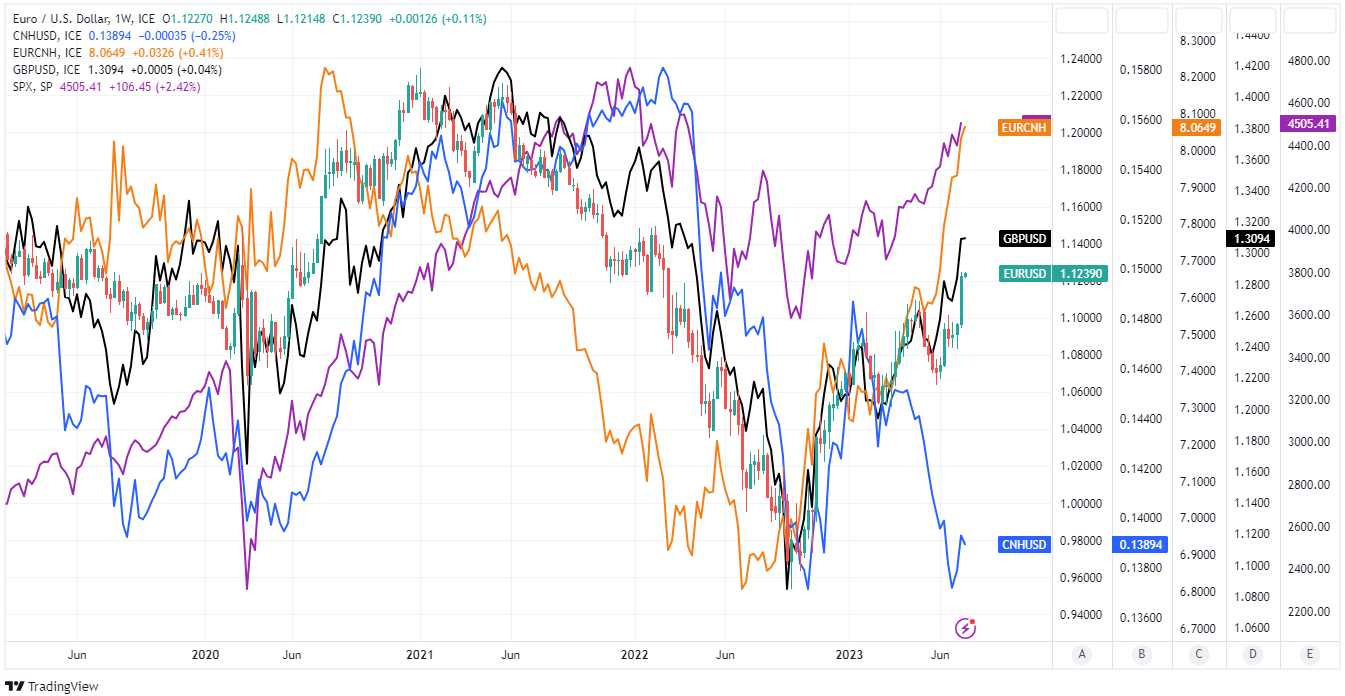EUR/USD Week Ahead Forecast: Technical Headwinds Loom Over Rally
- EUR/USD rally faces technical headwinds at 1.1273 & 1.1398
- Supported likely near 1.11 as USD, RMB & risky assets drive
- U.S. retail sales & final EU CPI in focus as calendar quietens

Image © European Union - European Parliament, Reproduced Under CC Licensing.
The Euro to Dollar exchange rate entered the new week at its highest since the invasion of Ukraine but technical resistances near and above 1.1273 on the charts could frustrate the recovery without either deeper losses for the Renminbi or a sustained rally from risky assets in the days ahead.
Europe's single currency appeared to benefit on Monday as Dollar exchange rates softened further and many of the largest counterparts within the China Foreign Exchange Trade (CFETs) Index rallied including the Euro, Japanese Yen and Korean Won after the Chinese economy grew slower than some forecasters expected for last quarter.
Data out on Monday indicated that last quarter's acceleration of the world's second-largest economy was softer than the consensus expected while appearing to suggest weak household spending growth was the culprit, leaving the Renminbi mired in widespread losses to open the new week.
"The trend of negative surprises was briefly interrupted last week when new Yuan lending data beating expectations, but GDP caused the trend to revert to the 2023 norm," writes Kenneth Broux, an FX strategist at Societe Generale, in a Monday market commentary.
"Tactically, we would not be surprised if the moves of last week have further to go and dips in EUR/USD and GBP/USD are bought," he adds.
Above: EUR/USD at daily intervals alongside Euro-Renminbi rate, GBP/USD and spread or gap between 02-year German and U.S. government bond yields. Click image for closer inspection.
The Euro-Renminbi pair reached its highest level since September 2020 on Monday while EUR/USD was changing hands at its best levels since February 2022 though gains in the latter also almost certainly had something to do with a further softening of the U.S. Dollar, which fell widely last week.
"Signs of disinflation in the US and a high level of scepticism about the ability of the Fed to hike rates beyond the July meeting, suggest that a soft USD is likely to prevail in the near-term," writes Jane Foley, head of FX strategy at Rabobank, in a forecast review.
"That said, signs that the ECB’s rate hike cycle is moving towards its peak suggests that EUR/USD could struggle to make further gains beyond the summer season. Additionally, if US recession fears strengthen into the end of the year, the USD could benefit from broad-based support," she adds while tipping EUR/USD to fall back to 1.11 in one month.
Dollars were sold widely last week when official data suggested U.S. inflation fell back to 3% and near the 2% target of the Federal Reserve (Fed) in June, leading to rallies for risky assets like stocks and commodities while lifting the Euro, Pound and other currencies relative to the greenback.
Last week's data has done little to alter market assumptions about the outlook for U.S. interest rates but the sell-off in the Dollar and loosening of financial conditions arising as a result of the rally in risky assets might mean a July, or perhaps even also a September, increase in borrowing costs is now likely.
Above: Quantitative model estimates of ranges for this week. Source Pound Sterling Live.
"EUR/USD is now looking quite expensive relative to our short-term fair value of 1.0957, which we estimate based on FX drivers like rate differentials and peripheral spreads to bunds among others," writes Valentin Marinov, head of FX strategy at Credit Agricole CIB, in a Monday market commentary.
"It should also be mentioned that the latest EUR/USD rebound brought it in line with its long-term fair value that we estimate based on real rate & yield spread, relative productivity, external position and commodity terms of trade. This could suggest that further EUR/USD upside would bring it into overvalued territory," he adds.
There is little in the economic calendar to influence expectations for U.S. Dollar interest rates this week but Wednesday's release of Eurostat's final estimate of inflation for June could impact the single currency if there is an up or downward revisions.
Economist surveys suggest the overall and core inflation rates were likely unchanged at 5.5% and 5.4% respectively for last month, however, and it might take a large revision in either direction to make an impact on market expectations for European Central Bank (ECB) interest rates.
"ECB President Lagarde and Chief Economist Lane attend an ECB conference in Frankfurt today, but we doubt hawkish remarks against the strength of the EUR will be heard there," says Roberto Mialich, an FX strategist at UniCredit.
Above: Euro to Dollar rate shown at weekly intervals with Fibonacci retracements of recent downtrends indicating possible areas of technical resistance for Euro. Selected moving averages denote support and/or resistance. Click image for closer inspection.
"We think EUR-USD will probably consolidate at around the current high levels ahead of the 26 June FOMC meeting. Investors will probably opt to wait and see what message Fed Chair Jerome Powell delivers during his press conference before driving the pair higher," he adds in a Monday market commentary.
Interest rate derivative market prices have for some time implied a high probability of the ECB raising its once-negative commercial bank deposit rate to 4% by year-end, meaning two further quarter percent increases are widely anticipated for the months ahead.
The bar for market pricing to rise further is a high one and more so since European inflation moderated from 7.1% to 5.5% declines in May and June to leave it sitting almost alongside the 5.4% core inflation rate.
"We expect continued tightening by the European Central Bank (recent downside data surprises have not changed our 4% terminal-rate expectation) and a widening of the Bank of Japan’s yield curve control band this month to support the EUR and JPY," says Parisha Saimbi, an FX strategist at BNP Paribas.
"We continue to project a rise in EURUSD to 1.18 by the end of 2024 and USDJPY to fall to 123, although we see a risk these targets are met earlier," she adds.
Above: Euro to Dollar rate shown at weekly intervals with Fibonacci retracements of recent downtrends indicating possible areas of technical resistance for Euro. Selected moving averages denote support and/or resistance. Click image for closer inspection.




